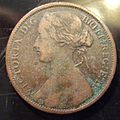Wikipedia talk:Featured article candidates/History of the British penny (1714–1901)/archive1
The history of the British penny from 1714 to 1901 saw the transformation of the penny from a little-used small silver coin to the bronze piece recognisable to modern-day Britons. All bear the portrait of the monarch on the obverse; copper and bronze pennies have a depiction of Britannia on the reverse. During most of the 18th century, the penny was a small silver coin. In 1797 Matthew Boulton produced millions of official pennies, of copper, at his Soho Mint in Birmingham.. After that, it was not until 1825 that pennies were struck again for circulation. By the late 1850s, the state of the copper coinage was deemed unsatisfactory, with many pieces worn, though still heavy. They were replaced by lighter bronze coins beginning in 1860; the "Bun penny", named for the hairstyle of Queen Victoria on it, was issued from then until 1894, succeeded by the the "Veiled head" or "Old head" pennies, coined from 1895 until her death in 1901.
Start a discussion about improving the Wikipedia:Featured article candidates/History of the British penny (1714–1901)/archive1 page
Talk pages are where people discuss how to make content on Wikipedia the best that it can be. You can use this page to start a discussion with others about how to improve the "Wikipedia:Featured article candidates/History of the British penny (1714–1901)/archive1" page.

